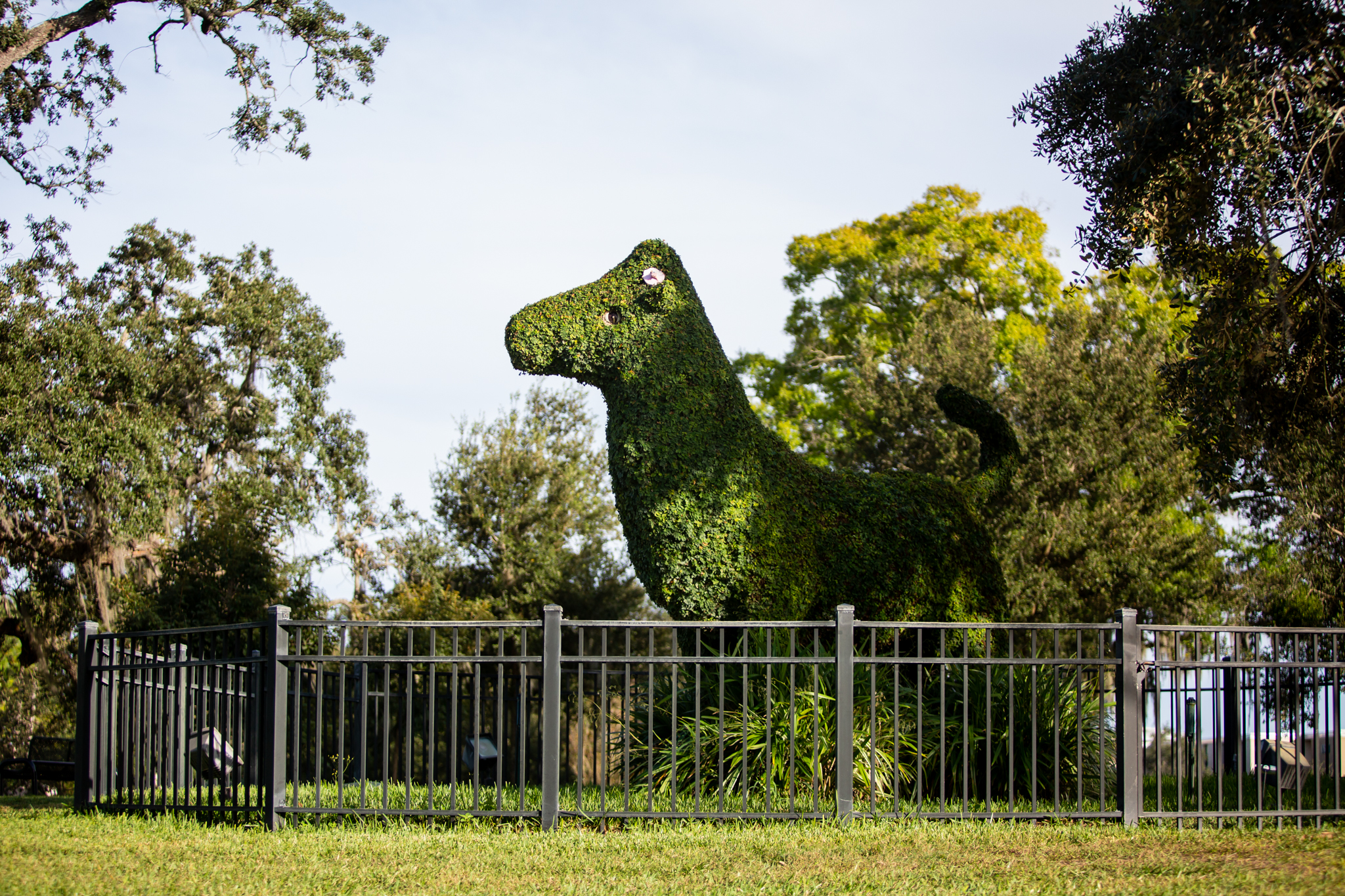Topiary bull target of vandalism, brings financial burdens

The topiary bull, located north of the Marshall Student Center (MSC), is a hard-to-miss landmark on campus, especially due to its size and golden horns that stand out from its greenery.
The issue with such an iconic sculpture, however, is the frequent thefts of its horns as part of a prank or a graduation “tradition” which Associate Director of Communications for Administrative Services Aaron Nichols said costs the university thousands of dollars yearly.
“It is a problem,” Nichols said. “I know people might think it’s just a harmless prank, but it’s the truth — it’s vandalism and it costs the university quite a bit of time and money to repair.”
On average, the horns get stolen four to five times a year. Nichols said the process to replace the horns takes one to two weeks.
The bull, also known as “Topibull,” was originally designed by William Robertson, who has done work for Walt Disney World and Busch Gardens. In total, the sculpture weighs around 1,000 pounds and has more than 3,000 welds.
Nichols said the horns were originally made of metal when the topiary bull was first installed in 2009. The total cost for it was around $27,000, former Assistant Vice President of Facilities Management Joe Eagan told The Oracle at the time.
The bull is not only made from plants, according to Nichols, as it uses a steel frame filled with creeping fig plants and water-retentive peat moss to make up the bull’s body.
Once the metal horns started getting stolen, Nichols said it significantly damaged the bull due to the force required to pull the horns from the structure. Besides the $1,500 to replace the horns, the university also had to cover $500 in damages to repair the sculpture.
Nichols said the material used to make the horns changed from metal to fiberglass as a more affordable option. The fiberglass option requires more intensive labor, but costs $500 to produce.
It takes 30 hours of work to shape and then apply fiberglass to the horns, according to Nichols. The team must then let it dry, sand, paint and install them on the bull.
In recent months, Nichols said the grounds team has been working with the engineering department to make the horns using a 3D printer. The process, however, is still as intense, according to Nichols.
The 3D printer takes 24 hours to make a single horn, which totals to 48 hours to make a pair. Since the horns are large in size, the team prints it in three separate sections and then glues all the parts together.
Nichols estimates the labor cost to produce a pair of fiberglass horns is $1,350. Replacing the damaged creeping fig plants and the labor required also comes with a hefty price, according to Nichols. Labor costs $240 to $275 to replace those plants.
The costs to replace and install the horns are covered through the grounds team’s maintenance budget. He said such expenses pull money away from essential services around the university.
“That’s an expensive thing,” Nichols said. “Every time somebody does this and thinks it’s a funny joke, it’s really not. And again, it’s an iconic symbol to the university and it’s a shame to us that people in the university community vandalize it.”
The team, he said, ensures the sculpture is taken care of and, when damaged, the crew works to return it to its original form.
“We’ve got a team that takes care of the topiary bull, which also gets damaged when people pull the horns off,” he said. “They do this because they know it’s an iconic symbol, and it’s very meaningful to them. They love the university and they kind of show it through the gear that they put into that.”
The thefts, according to Nichols, tend to happen in the evening, and University Police (UP) is aware of the issue.
“Unfortunately, when it happens as far as the [grounds team] doing anything about it, it’s after hours, and we don’t have people that we spare to guard the bull,” he said.
Stealing the horns or damaging the sculpture is vandalism, according to UP Public Information Representative Audrey Clarke. Individuals involved in such actions could face criminal prosecution and/or administrative sanctions imposed through the university.
“The topiary bull on Crescent Hill is property of the University of South Florida and its maintenance requires an investment of budgetary and staffing resources,” Clarke said. “Defacing the bull or removing any parts of it are crimes and will be investigated as such.”
A potential solution to the issue was to attach the horns to a metal bar, however, the idea didn’t go through because it could damage the topiary even more if individuals removed it.
“There’s a balance between [if] we’re going to make it hard for the vandals to get the horns off or risk severe damage to the topiary or just know that it’s going to happen and maybe they’re not going to damage the topiary badly,” Nichols said.
“I’m not sure what the solution is because again, if we make the horns harder to steal, then we’re going to risk damaging the topiary. I also [recognize] the fact that we have limited security resources, so we can’t just be there all the time.”
Nichols said the idea of making the plant shaped like horns would be difficult, so there are no plans to implement that idea. With such an iconic landmark, Nichols said there are no plans to remove the sculpture in its entirety.
“I hope people reading it kind of better understand the impact of things like that, whether it’s taking the horns off the topiary bull or any other things they might consider just pranks or maybe they’ve even became traditions in some areas, but they sometimes do have negative impacts on the university and [its] community,” Nichols said.







